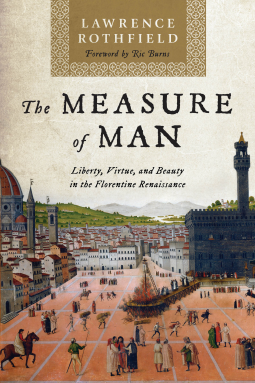
The Measure of Man
Liberty, Virtue, and Beauty in the Florentine Renaissance
by Lawrence Rothfield - Foreword by Ric Burns
This title was previously available on NetGalley and is now archived.
Send NetGalley books directly to your Kindle or Kindle app
1
To read on a Kindle or Kindle app, please add kindle@netgalley.com as an approved email address to receive files in your Amazon account. Click here for step-by-step instructions.
2
Also find your Kindle email address within your Amazon account, and enter it here.
Pub Date Mar 01 2021 | Archive Date Feb 24 2021
Talking about this book? Use #TheMeasureofMan #NetGalley. More hashtag tips!
Description
It was one of the most concentrated surges of creativity in the history of civilization. Between 1390 and 1537, Florence poured forth an astonishing stream of magnificent artworks. But Florentines did more during this brief period than create masterpieces. As citizens of a fractious republic threatened from below, without, and within, they also were driven to reimagine the political and ethical basis of their world, exploring the meaning and possibilities of liberty, virtue, and beauty.
This vibrant era is brought to life in rich detail by noted historian Lawrence Rothfield in The Measure of Man. His highly readable account introduces readers to a city teeming with memorable individuals and audacious risk-takers, capable of producing works of the most serene beauty and acts of the most shocking violence. Rothfield’s cast of characters includes book hunters and book burners, devout Christians and assassins, humble pharmacists and arrogant oligarchs, all caught up in a dramatic struggle—a tragic arc running from the cultural heights of republican idealism in the early fifteenth century, through the aesthetic flowerings and civic vicissitudes of the age of the Medici and Savonarola, to the brooding meditations of Machiavelli and Michelangelo over the fate of the dying republic.
Available Editions
| EDITION | Hardcover |
| ISBN | 9781538143360 |
| PRICE | $26.95 (USD) |
Featured Reviews
 Reviewer 499835
Reviewer 499835
I enjoyed reading this history of Florence at its height of cultural relevance the way I'd enjoy sitting at the Caffetteria delle Oblate with a very good view of the Duomo on a cool fall day in September after the summer tourists have gone home. The name of the book--unabashedly called the measure of MAN--without any fussy gestures toward gender parity--hints at what's inside. Reading it is something like sitting down to have a nice conversation about the Florentine Renaissance with somebody who looks like Alistair Cooke. Never over-academic. Full of human happenings. Elegant, observant, patrician, erudite, slightly regal, and always entertaining. I loved it.
It is not readily apparent why a student of the American Revolution and Congressional history would be drawn to Lawrence Rothefield’s The Measure of Man: Liberty, Virtue, and Beauty in the Florentine Renaissance. The book explores the tumultuous time period between 1390 and 1537 in Florence, Italy. It includes the shocking details of the lives of the political and social elites and the violence and unrest that came with the “...tragic arc running from the cultural heights of republican idealism in the early fifteenth century, through the aesthetic flowerings and civic vicissitudes of the age of the Medici and Savonarola, to the brooding meditations of Machiavelli and Michelangelo over the fate of the dying republic.”
The name Machiavelli is what caught this reader’s eye. Several of the Founders studied his works including Benjamin Franklin, John Adams, and James Madison. In a world separated from European cultural and political heritage, many of the Colonies’ young leaders learned how to build a republic by being voracious readers. Machiavelli’s writings were at the top of their list. John Adams had them in his personal library. James Madison requested The Works of Nicholas Machiavel for use by the Congress in 1783.
We would be doing Rothfield an injustice to critically analyze his description of Florentine history. That kind of analysis would be better left to an actual historian who has more knowledge about the era and subject matter. However, it is fascinating to learn more about the society that inspired the man who inspired the men who birthed the United States. In that respect, Rothfield makes some interesting observations that are relevant to studying the American Revolution.
The book describes a relatively rigid leadership structure. Even Machiavelli was limited by the caste system. Despite the impact his writings would have on future generations, he did not wield that same influence while alive and failed to have a lasting career as part of the Florentine political ruling class. Similarly, the Founders, although wealthy and respected merchants, were not a part of the British elite. George Washington’s rejection by the British Army is a case in point.
Another interesting point comes when Rothfield explores Machiavelli’s political and governing philosophy, particularly as it relates to the importance of having a militia. He states that “To be strong [Machiavelli] insisted a republic needed to create its own native militia instead of relying on the arms of others.” This idea was further promoted by military themed paintings by the likes of Michelangelo and Leonardo Da Vinci. Almost 250 years later, one of the first actions the Second Continental Congress took on the way to declaring independence from Great Britain was to develop a standing army. They realized that there would be no way they could separate from the British if they could not develop a means to drive the British army out and protect the Colonies.
Those are just a few of the highlights of the book that might interest a studier of the Founding era. In total, The Measure of Man is a riveting book that provides a detailed account of Florence’s decadent leaders, the intersection of politics and art at the time, and the Florentine “Renaissance spirit.” As Rothfield notes “Two centuries later, on another continent, it would be again reincarnated as a republican ethos of civic virtue and adherence of liberty, with very different philosophical justifications but similar travails.”



